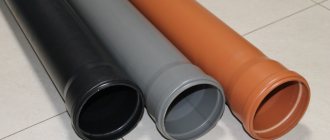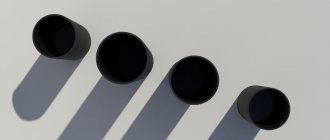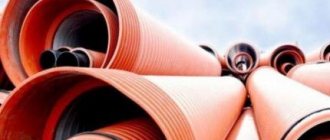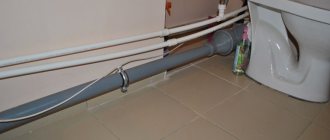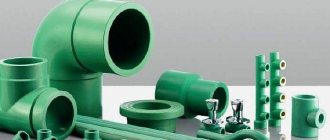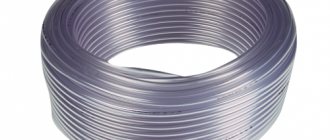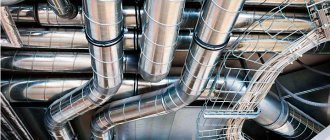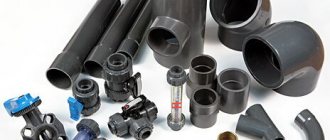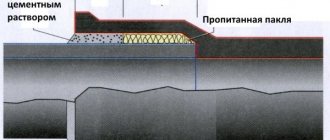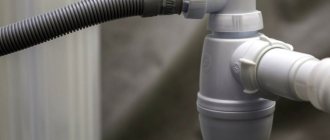The fact that PVC pipes are used to install sewer systems is not new. But when a person is faced with the choice of material for external or external sewerage, he notices that it differs in color.
The thing is that modern manufacturers paint products for various purposes in different colors to make it easier for the consumer to navigate. As soon as plastic sewerage began to be produced, it is painted gray for internal systems, and orange for external systems.
Moreover, they differ not only in appearance.
Pipes for external and internal work
What does the color of sewer pipes mean?
Sewage can be internal or external. Pipes for external sewerage are marked in red (orange, light brown, mustard) color.
Product markings serve to make it easier to understand what type of pipes you have in front of you - in a hypermarket, at first glance you can distinguish green pipes for storm drains, external or internal sewerage (gray or white). During storage, transportation and installation work, the multi-colored pipes also make the work of personnel easier. The bright orange color for external systems was chosen because when excavating, especially with the help of machinery, brightly colored pipes are much easier to detect in the ground.
Construction of an external sewerage system
The beginning of the external sewage system is the exit of the pipeline from the house or any other building, and the end is a reservoir for collecting wastewater and its subsequent treatment, for example, a septic tank.
Algorithm for constructing external sewerage:
- Design of an external sewer circuit, including the location of pipes and septic tank.
- Calculation of the required number of red pipes with a diameter of 110 mm (or more) and their acquisition and transportation to the place where the circuit will be installed (about
Purpose, technical characteristics and properties
Red sewer pipes are intended for installation of external sewer networks.
Technical characteristics of sewer pipes:
- Sufficient strength and resistance to crushing.
- Resistance to aggressive environments and biological contaminants.
- Durability.
- Corrosion resistance.
- Frost resistance.
- Possibility of creating a sealed pipeline.
- They are light in weight - convenient for transportation and installation.
- The walls of pipes for external systems are thicker than for internal ones.
- They are easy and quick to install and have the necessary range of fittings and components for installation.
In addition, plastics can withstand the freezing of water pipes; after deformation, they return to their original shape.
PVC and HDPE socket pipes for external sewerage (for drains) are produced with outer diameters from 110 to 1200 mm and wall thicknesses from 2.7 to 36.7 mm. With a diameter of 110 mm, the wall thickness is 2.7-3.4 mm, with a diameter of 160 mm - 4-4.9 mm.
Standard sizes: 110, 125, 160, 200, 215, 315, 400, 500, 630, 800,1000, 1200 mm. Corrugated products are produced in the same sizes and fit together with smooth-walled products (but their internal diameter is slightly smaller). Length - from 0.5 to 6 m, rarely found up to 9 m long. PP pipes are mainly produced with a diameter of 110 mm, maximum 200 mm. Pipes of standard sizes 50-60-75-90 mm are used only for the installation of communication lines and electrical networks; such small diameters are not used for external sewerage.
Classification of single-layer pipes in accordance with EN 1401, EN 1852 and DSTU B V.2.5–32:2007 according to the ring stiffness indicator SN: there are two classes SN4 and SN8. Class SN8 is used for laying communications at greater depths or in more difficult conditions.
Areas of use
Sewerage is a network of pipelines designed to collect and drain wastewater and storm water outside cities and industrial enterprises. Without the existence of sewerage, it is impossible to provide a person with an appropriate level of comfort and hygiene.
The scope of distribution of sewerage includes residential areas, public buildings, industrial enterprises, agricultural and mining facilities, energy, transport - wherever a person lives, works or plays, there is a sewerage system.
The creation of modern strong, durable and reliable plastics has led to the fact that plastic pipes are replacing steel, cast iron and concrete products wherever possible. Gravity and pressure sewerage is precisely the area where plastic pipelines can be used. Although the scope of plastic pipes is limited to diameters of 1200 mm, these diameters are used for almost all sewer networks, with the exception of the largest sewers.
Features of polypropylene and polyethylene pipelines for external networks
When it comes to polypropylene, its main advantage is its resistance to high temperatures. This material has no restrictions on the temperature of the transferred liquid, and in addition is suitable for both pressure and non-pressure systems. The elasticity of polypropylene is several times higher than that of PVC.
However, the most flexible line today is polyethylene. It is not afraid of freezing, because in case of slight deformation it can easily restore its shape. The best option for PE products for external laying is a two-layer red corrugated line, produced with a round cross-section of large diameter (from 110 mm).
Basic requirements for a sewer pipe
Products for external sewerage are subject to increased strength requirements: they are located in the soil and experience constant pressure from the soil layer.
Basic requirements for pipes for external sewerage:
- Durability, resistance to crushing.
- Durability.
- Chemical inertness - the pipe should not rust, become overgrown with salts, react with aggressive environments, or be destroyed by bacteria.
- Plastic.
- Frost resistance - does not collapse when working at subzero temperatures and freezing with water inside.
- The smoothness of the internal walls prevents the accumulation of salts on the walls and allows the contents to pass through more quickly.
In addition, the pipe system should be easy to install; there should be a sufficient range of fittings for installation and creation of a network of any configuration.
Connection type
There are three types of connecting elements:
- bell-shaped for a rubber ring. This is the most convenient and simplest option that does not require any additional devices during assembly. The installation process is reminiscent of a children's construction set - the free end is simply inserted into the socket of the previous element. The work is simple and quick, and can be done well even by inexperienced people;
- bell-shaped for sealing. These elements require the use of special glue or welding. The assembly process is significantly slower and more complicated, but the quality and reliability of the connections is noticeably different from other types;
- socketless. Assembly is carried out using coupling or welded connections. Special equipment and experience in such work are required. This method is rarely used due to the complexity and long duration of the process.
The main type of connection is a socket with a rubber seal. During installation, you cannot immerse the free end all the way; you must leave a little free play for thermal expansion of the material.
What material is used to make a red pipe?
For the manufacture of red sewer pipes, polyvinyl chloride, polypropylene and low-density polyethylene are used. High-density polyethylene and cross-linked polyethylene are practically not used due to their high price and plasticity - these materials lack rigidity, and pipes in the ground will wrinkle.
Polypropylene PP
Polypropylene is produced by the polymerization of propylene. PP is the lightest of the three types of plastic. This hard plastic is very durable and abrasion resistant, resistant to elevated temperatures (up to 90°C), and can operate in temperatures as low as -10°C. Under impact loads it is more fragile than other plastics, but under slow deformation it is very durable. Has a high coefficient of thermal expansion.
Due to its resistance to high temperatures, PP is often used for intra-house networks. The strength of PP is less than that of HDPE and polyvinyl chloride - therefore, products with a maximum diameter of 200 mm are used for external systems.
Polyethylene PE
Low-density polyethylene is very widely used for external sewerage. This material is characterized by high strength and ductility. A big plus is its resistance to operation at low temperatures – down to -70°C.
HDPE is also used for pressure systems. For this purpose, they do not use socketed products, but ordinary long pipes.
Polyvinyl chloride PVC
PVC is the most durable of all types of plastic. Most often it is used for socket pipes. The disadvantage is that frost resistance is not very high - down to -10°C.
Corrugation
For sewer systems, rigid two-layer corrugation (heavy, super-heavy) is used. The strength of corrugation is higher than that of a single-layer pipe, so it is used when the network is deep (deeper than 2 m or under other difficult conditions). Bell-shaped products 6 m long are usually made from corrugation.
The outer layer of corrugation is made of PVC and HDPE, less often PP; the inner layer is made of high-density polyethylene - here its plasticity came into place.
Properties of PVC as a material
The matrix base of the red PVC pipe is polyvinyl chloride. The material is fire-resistant, frost-resistant, has a low melting point, and is lightweight. Polyvinyl chloride exhibits dielectric properties, is not flammable, has sufficient rigidity, however, under strong bending or mechanical stress it can break.
PVC pipes have high strength characteristics and successfully compete with steel and cast iron
The spread of PVC among the main materials of sewerage systems is explained by its increased resistance to alkalis, acids, petroleum products and other aggressive substances. It can withstand temperatures up to 120 degrees.
Note! At this temperature, PVC loses its shape, begins to release HCl (hydrogen chloride), and practically becomes unusable.
Deformation of products made from such material occurs already at temperatures of +65-70 ºС. For this reason, it is not advisable to use channels for hot water supply.
Advantages and disadvantages
In addition to the properties of plastic pipes listed above, they have other significant advantages and almost weightless disadvantages.
Advantages:
- The durability of plastic reaches 50 years or more.
- Low cost.
- Strength is combined with plasticity and the ability to restore its shape after freezing or deformation.
- Cold resistance for PVC and PP is -10°C, HDPE - up to -70°C.
- No fragility.
- Harmless to humans and animals.
- Smooth walls that are not overgrown with salts have little hydraulic resistance - this speeds up the evacuation of wastewater.
- Environmental friendliness – relatively harmless production and disposal.
- Easy installation - pipes are easy to cut and even bend (small diameters); We produce a wide range of all kinds of fittings and components; No highly qualified plumbers are required.
- There are advantages that are not very necessary when laying underground communications - for example, PVC is resistant to ultraviolet radiation; PP and PVC can withstand temperatures up to 65-80 °C, but such temperatures usually do not occur in external networks. (Can be in industrial networks - with a large volume of hot water flow or steam discharge).
Flaws:
- Plastics have less strength than steel, reinforced concrete and cast iron. But there are no high pressures in sewer lines (especially in the most common gravity ones).
- If wastewater containing food fats gets into plastic sewers, then after a few years the pipes will begin to become clogged with fats, and the system will have to be cleaned. Acids, alkalis and surfactants are practically powerless for cleaning.
Differences from PVC pipes
To produce polyvinyl chloride, plasticizers are added to the feedstock, which impart softness and plasticity to the material. This greatly simplifies the processing and installation of PVC products.
Eliminating plasticization from the production process makes the resulting product more rigid and durable. Therefore, uPVC pipes are superior in strength to their PVC counterparts.
According to GOST, the color of external PVC-U sewer outlets is orange-brown. PVC bends are used for internal wiring and are supplied in gray color.
Types and differences
According to their purpose, sewerage is divided into ordinary external (orange pipe) and storm and drainage (green, sometimes blue).
By design there are: bell-shaped products, smooth pipes and two-layer strong corrugation. Corrugated pipes are used if the system will lie at great depth, the site is located in an earthquake-prone area, or there is a possibility of soil movement.
Long smooth pipes are used in pressure sewerage; they are installed like a water supply system - using fittings, welding/soldering, gluing (PVC). For the installation of gravity free-flow systems, socket-shaped products are used.
Depending on the method of transportation, sewerage can be either pressure or non-pressure.
Nadornaya
Pressure sewer systems are very rare - only if it is not possible to install a gravity system. As a rule, they are used in the following cases:
- If the adjoining system is located above the level of the city sewer.
- If the treatment plant is located above the storage tank (this often happens in urban treatment facilities).
- If there is an insurmountable obstacle of great height on the sewer route.
In such a system, wastewater enters a storage tank and is pumped into a collector or septic tank using a pump.
The advantage of the pressure system is the possibility of construction in difficult conditions, the ability to use long-distance communications and small-diameter pipelines. Disadvantages - the need for control, maintenance and repair of the pump, clogging of the system when the crusher of large inclusions breaks down.
Gravity
Typically, sewer systems are constructed as gravity-flow systems. They are much simpler; a well-designed system does not require attention for a long time, sometimes for years. Evacuation of the contents occurs due to the slope under the influence of gravity. The great advantage of gravity sewerage is its reliability.
Features of pressure and non-pressure pipes
Non-pressure products are designed to operate in areas of the system with normal load. Most sewers are characterized by precisely these conditions. Therefore, it is possible to assemble the circuit mainly from such cheaper pipes.
In those sections of the system where waste liquids are distilled using a pump, that is, under increased pressure, it is necessary to use pressure-type products that can withstand heavy loads. The same applies to areas with particularly difficult operating conditions.
The use of a pump in autonomous sewer circuits is necessary because it helps clean the system. The pressure created by it is not constant and is characterized by an alternating increase and decrease, which creates a special load on the pipeline. Therefore, more expensive but safe pressure pipes must be installed in sewerage areas located in the pump’s operating area.
Choosing the right pipe
There is only one piece of advice for choosing a sewer system: if possible, install a gravity sewer - it will cost much less than a pressure sewer, and is much simpler to implement. And does not require special supervision and maintenance.
Product size and diameter
When installing sewerage in a private house, a pipe with an outer diameter of 110 mm is sufficient. A diameter of 160 mm makes sense only if you have many family members and many bathrooms at home. The lengths of bell-shaped products are used by determining locally which are convenient. A diameter of 200 mm does not make sense to use in a private home.
Popular manufacturers
Plastic sewer pipes are produced by everyone who can. This is a simple, popular and profitable product. There is also no fundamental difference between the materials, although PVC, of course, is stronger (and cheaper) and is more often found in stores. You should pay attention to the appearance of the pipes, color, presence of a certificate, and especially to the wall thickness - does it correspond to what is stated in the documents.
approximate price
Plastic socket pipes with components are inexpensive. For example, a polypropylene pipe 2 m long and 110 mm in diameter will cost from 300 rubles; with a diameter of 50 mm - from 110 rubles; with a diameter of 50 mm and a length of 1 m - 60 rubles. Polyethylene and polyvinyl chloride will cost about 30% less. Imported products are sold several times more expensive. Prices depend on the region and seller markups.
Green or blue plastic pipes
This is a color for drainage pipes that combine flexibility and rigidity.
Their walls are strong and can withstand a large layer of soil.
Resistant to temperature changes. This fact makes them simply irreplaceable in their field.
Another feature is the perforated surface. It ensures that water gets inside the material. There are 110 mm, 160 mm in coils of 50 m, 200 mm in coils of 40 m.
Installation nuances
Installing an external sewer system in your home using socket elements is simple and easy to do with your own hands.
Installation of an external sewerage network
Long external sewers must have inspection wells. The distance between them should not exceed 50 meters; only one turn of the pipeline is allowed between them. This is done so that the system is accessible for cleaning.
Laying is done from the well (or collector, or septic tank).
Features of channel installation
The most labor-intensive part of the work is excavation work. The optimal trench width is 25-30 cm. It is advisable to hire a trench excavator (“bar”). There are also small-sized excavators with trenchers and machines for cutting ditches. You can do it the old fashioned way - by hand. Wide places are excavated near the walls of the house and near the wells; the rest of the trench should be as narrow as possible (saves effort and sand). All turning points must be located in dry manholes large enough to allow a person to descend and operate the turning point.
Sand 10-15 cm thick is poured onto the bottom of the trench, compacted using a tamper, and a slope of 2-8 mm per linear meter is arranged.
How to properly lay sewer pipes in a country house
The socket of the last pipe of the external system must be located inside the foundation and must be insulated. Before joining the two elements, rubber cuffs are lubricated with silicone sealant to increase the tightness.
The pipeline should not bend up or down, and there should not be strictly horizontal sections. Having assembled the system, it is tested and insulated. Then they are covered with a layer of sand 100-150 mm thick, lightly compacted and filled with water (for compaction). Pour the soil into the trench, lightly compact it, and spill it with water.
Do not greatly exceed the slope for external sewerage - this will lead to a strong deepening of the trench and an increase in the volume of excavation work.
Circuit installation tips
It is impossible to increase or decrease the slope, especially of external sewerage. This leads to solids retention and blockages. It is not advisable to clean the drain using chemicals or pour out hot water - this can damage the system.
The minimum depth for laying the pipeline is 30 cm above the soil freezing level. In this case, the sewerage system will require insulation. Such a pipeline must be insulated. They use penofol - sheets of foamed polyethylene covered with foil; polystyrene foam shells. You cannot use mineral or glass wool because of their hygroscopicity.
